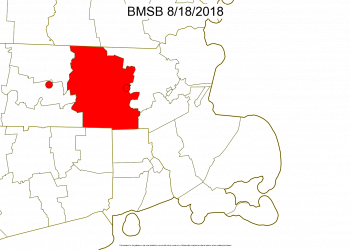Fruit Program News
-
New England Cider Apple Program at the NEVFC
-
April Fruit Twilight Meetings
-
MFGA Annual Meeting and UMass Extension Education Program
-
Brown Marmorated Stink Bug
While trap captures are begining to increase, Brown Marmorated Stink Bug populations remain below threshold for tree fruit crops. There is not, currently, any recognized population threshold in small fruit. See the New England Tree Fruit Management Guide or the New England Small Fruit Management Guide for more information.
-
Spotted Wing Drosophila Spray Tables for 2018
-
2017 Program Survey
-
Grape Disease Control for 2017 - Dr. Wayne Wilcox
-
Fire blight conditions bordering on EXTREME
As of Friday morning, May 8, 2015, the risk of getting fire blight as we move into the weekend is very high to extreme across most of Massachusetts. Depending on your state of apple or pear bloom, the application of streptomycin to open bloom is highly recommended, maybe even essential. We have numerous resources available for helping you manage fire blight in 2015:
- An Annual Fire Blight Management Program for Apples: an Update
- May 5, 2015 Healthy Fruit
- Network for Environment and Weather Applications (NEWA)
- AgRadar
- New England Apple Decision Support System Maps
Please take this situation seriously so we can minimize the amount of fire blight we have in 2015. By the middle of next week, the fire blight risk should be less severe. If you do get fire blight symptoms, please let us know -- jon.clements@umass.edu, 413-478-7219, or Daniel Cooley, 413-531-3383 -- as we are surveying for fire blight resistance to streptomycin in 2015.
-
2015 Healthy Fruit Newsletter
Healthy Fruit is a timely newsletter that includes information on tree-fruit horticulture, pest management, and related topics. The primary reader is the commercial grower, but anyone growing fruit trees will benefit.
-
2015 New England Tree Fruit Management Guide
2015 New England Tree Fruit Management Guide
A collaboration of tree fruit specialists in all six New England states, and with Cornell University, the 2015 New England Tree Fruit Management Guide (NETFMG) is a must-have for all commercial orchardists. The 2015 NETFMG is 283 pages and includes chapters on: Integrated Crop & Pest Management; Organic Tree Fruit Production in New England; Pesticide and Sprayer Information; Characteristics of Crop Protectants Used on Tree Fruits; Disease, Insect, Weed, Wildlife, and Nutrient Management; and specific spray management recommendations for Apples, Pears, Cherries, Peaches and Nectarines, Apricots, and Plums and Prunes. The 2015 NETFMG is available for purchase for $25 on the UMass Extension Bookstore. (Or you can also use this mail-in form to order Healthy Fruit and other UMass fruit publications.) The 2015 NETFMG will also be available for sale at Fruit Twilight Meetings.





